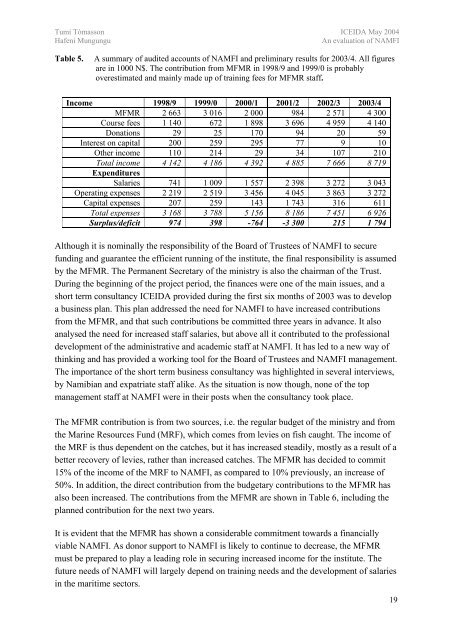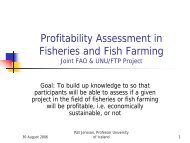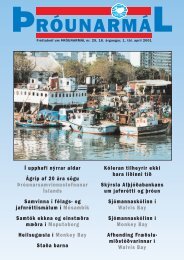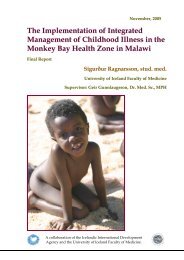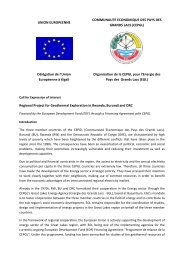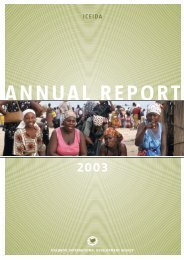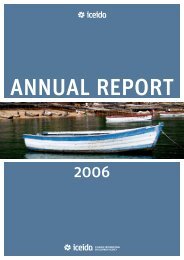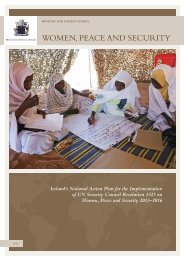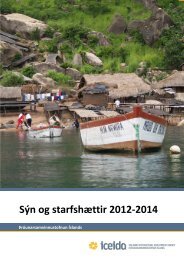An Evaluation of the NAMFI/ICEIDA Cooperation Project 2002 -2004
An Evaluation of the NAMFI/ICEIDA Cooperation Project 2002 -2004
An Evaluation of the NAMFI/ICEIDA Cooperation Project 2002 -2004
Create successful ePaper yourself
Turn your PDF publications into a flip-book with our unique Google optimized e-Paper software.
Tumi Tómasson <strong>ICEIDA</strong> May <strong>2004</strong><br />
Hafeni Mungungu<br />
<strong>An</strong> evaluation <strong>of</strong> <strong>NAMFI</strong><br />
Table 5.<br />
A summary <strong>of</strong> audited accounts <strong>of</strong> <strong>NAMFI</strong> and preliminary results for 2003/4. All figures<br />
are in 1000 N$. The contribution from MFMR in 1998/9 and 1999/0 is probably<br />
overestimated and mainly made up <strong>of</strong> training fees for MFMR staff.<br />
Income 1998/9 1999/0 2000/1 2001/2 <strong>2002</strong>/3 2003/4<br />
MFMR 2 663 3 016 2 000 984 2 571 4 300<br />
Course fees 1 140 672 1 898 3 696 4 959 4 140<br />
Donations 29 25 170 94 20 59<br />
Interest on capital 200 259 295 77 9 10<br />
O<strong>the</strong>r income 110 214 29 34 107 210<br />
Total income 4 142 4 186 4 392 4 885 7 666 8 719<br />
Expenditures<br />
Salaries 741 1 009 1 557 2 398 3 272 3 043<br />
Operating expenses 2 219 2 519 3 456 4 045 3 863 3 272<br />
Capital expenses 207 259 143 1 743 316 611<br />
Total expenses 3 168 3 788 5 156 8 186 7 451 6 926<br />
Surplus/deficit 974 398 -764 -3 300 215 1 794<br />
Although it is nominally <strong>the</strong> responsibility <strong>of</strong> <strong>the</strong> Board <strong>of</strong> Trustees <strong>of</strong> <strong>NAMFI</strong> to secure<br />
funding and guarantee <strong>the</strong> efficient running <strong>of</strong> <strong>the</strong> institute, <strong>the</strong> final responsibility is assumed<br />
by <strong>the</strong> MFMR. The Permanent Secretary <strong>of</strong> <strong>the</strong> ministry is also <strong>the</strong> chairman <strong>of</strong> <strong>the</strong> Trust.<br />
During <strong>the</strong> beginning <strong>of</strong> <strong>the</strong> project period, <strong>the</strong> finances were one <strong>of</strong> <strong>the</strong> main issues, and a<br />
short term consultancy <strong>ICEIDA</strong> provided during <strong>the</strong> first six months <strong>of</strong> 2003 was to develop<br />
a business plan. This plan addressed <strong>the</strong> need for <strong>NAMFI</strong> to have increased contributions<br />
from <strong>the</strong> MFMR, and that such contributions be committed three years in advance. It also<br />
analysed <strong>the</strong> need for increased staff salaries, but above all it contributed to <strong>the</strong> pr<strong>of</strong>essional<br />
development <strong>of</strong> <strong>the</strong> administrative and academic staff at <strong>NAMFI</strong>. It has led to a new way <strong>of</strong><br />
thinking and has provided a working tool for <strong>the</strong> Board <strong>of</strong> Trustees and <strong>NAMFI</strong> management.<br />
The importance <strong>of</strong> <strong>the</strong> short term business consultancy was highlighted in several interviews,<br />
by Namibian and expatriate staff alike. As <strong>the</strong> situation is now though, none <strong>of</strong> <strong>the</strong> top<br />
management staff at <strong>NAMFI</strong> were in <strong>the</strong>ir posts when <strong>the</strong> consultancy took place.<br />
The MFMR contribution is from two sources, i.e. <strong>the</strong> regular budget <strong>of</strong> <strong>the</strong> ministry and from<br />
<strong>the</strong> Marine Resources Fund (MRF), which comes from levies on fish caught. The income <strong>of</strong><br />
<strong>the</strong> MRF is thus dependent on <strong>the</strong> catches, but it has increased steadily, mostly as a result <strong>of</strong> a<br />
better recovery <strong>of</strong> levies, ra<strong>the</strong>r than increased catches. The MFMR has decided to commit<br />
15% <strong>of</strong> <strong>the</strong> income <strong>of</strong> <strong>the</strong> MRF to <strong>NAMFI</strong>, as compared to 10% previously, an increase <strong>of</strong><br />
50%. In addition, <strong>the</strong> direct contribution from <strong>the</strong> budgetary contributions to <strong>the</strong> MFMR has<br />
also been increased. The contributions from <strong>the</strong> MFMR are shown in Table 6, including <strong>the</strong><br />
planned contribution for <strong>the</strong> next two years.<br />
It is evident that <strong>the</strong> MFMR has shown a considerable commitment towards a financially<br />
viable <strong>NAMFI</strong>. As donor support to <strong>NAMFI</strong> is likely to continue to decrease, <strong>the</strong> MFMR<br />
must be prepared to play a leading role in securing increased income for <strong>the</strong> institute. The<br />
future needs <strong>of</strong> <strong>NAMFI</strong> will largely depend on training needs and <strong>the</strong> development <strong>of</strong> salaries<br />
in <strong>the</strong> maritime sectors.<br />
19


